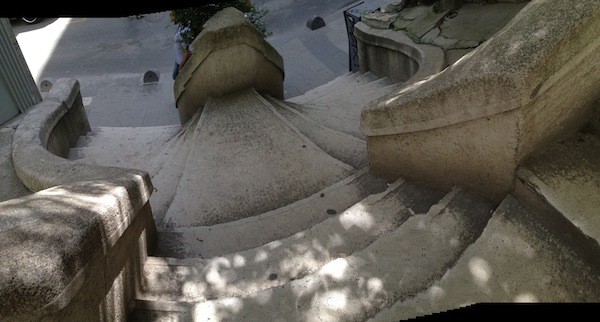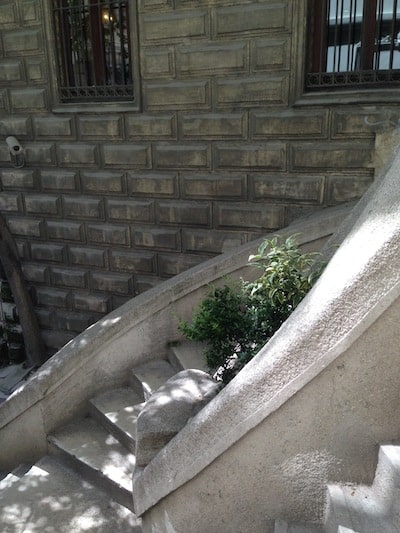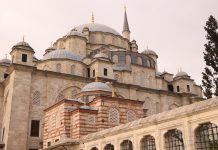Strolling through Istanbul requires two basic skills: a good sense of direction and a strong pair of legs. The steep hills and windy streets of the city can be challenging to navigate, and they will most certainly tone your leg muscles. And is not a so well-kept secret that the best spots in the city are always on the top floor of a building with no elevator, or after a hike up a steep and narrow street. The bright side of this feature of the city is that Istanbul is full of those wonderful structures that connect two points at different heights: stairs.

A year ago, during the Gezi protests, one rainbow-colored staircase came into the spotlight and made Istanbulites understand that simple steps can be elevated to art form. Usually, they go unnoticed during the everyday rush to work and are seen only as a way to access other marvels of the city. But if you look carefully, you can find some neat stairs that spruce up the hidden corners of the city and enrich the urban landscape. Right across from the multipurpose space, SALT Galata, located in the upcoming neighborhood of Karaköy, you can find what is probably the most eclectic staircase in the city: the Camondo stairs.
It almost seems as if the modernist architect Antoni Gaudí himself had taken a dreamy voyage and landed in Istanbul to bestow this trippy set of stairs upon the city. Their function is to connect Bankalar Caddesi — the street where all the banks and the Bourse used to be in the late Ottoman period — with Bereketzade Medresesi Sokak, one of the streets that leads straight to Galata Tower. But these steps go beyond their function and have become a unique and organic urban design embedded in the dense edification of the district. In short, these stairs are like nothing else you have seen around the city.

This curvaceous staircase was built circa 1870-1880 and was financed by the banker Abraham Camondo. A Sephardic Jewish family, the Camondo clan originally moved from Spain to Venice after the 1492 Alhambra Decree, an edict ordering the expulsion of those Jews who refused to convert to Catholicism from the Kingdoms of Castile and Aragon. After Venice ceded to Austria in 1798, members of the Camondo family settled in Istanbul. They flourished as bankers in Galata, then at the outskirts of the city, forming their own bank and extending credit to the Ottoman government.
As in other European cities, the leading bankers in Istanbul established their economic and social status by means of their philanthropic activity and patronage of the arts. The Camondos left their imprint on nineteenth century Istanbul with such architectural heritage as the Camondo Palace, currently being used by the Turkish Navy as the headquarters of the Northern Sea Area Command (Kuzey Deniz Saha Komutanlığı), the Camondo apartments, located close to the Galata Tower, and these impressive stairs.
The stairs were supposedly built to facilitate the transport of Camondo’s children to their school and as a shortcut for Camondo to quickly reach Bankalar Caddesi. The hexagonal shape of the staircase was supposedly designed in this way so that if one of the children were to slip, the curved banister would prevent them from falling further.

When people think of Istanbul, what immediately comes to mind are the buildings associated with the Byzantine Empire (Hagia Sophia, the Yerebatan Cistern) or the Ottomans (Topkapı Palace, Sultanahmet Mosque). But in the late nineteenth century, Istanbul became a center of the Art Nouveau movement, which left a magnificent architectural heritage. This gorgeous pedestrian piece has curvy flowing lines that follow the classical organic concept of this style. The nature-inspired theme and spiraling handrail almost brings this stairway to life thanks to the illusion of motion, a central feature of the Art Nouveau style. It very nearly resembles a river flowing downward between two mountains.
The stairway is divided into three sections. The latter begins with two symmetrical sections on each side, which are approaching each other and result in the central landings, flanked by high party walls. On the first landing, a plaque reminds us that these stairs were commissioned by the Camondos. In the central space between the two sections there are three plain stone planters. This grand structure was immortalized by the celebrated French photographer Henri Cartier-Bresson in 1964, and still makes for a sublime photo shoot.
The staircase is a fascinating and, at the same time, very difficult piece of architecture to execute. It is perhaps the element that has led to some of the most memorable places in the history of our art. Just think of the stairs in the Paris Opera by Charles Garnier or the Laurentian library staircase by Michelangelo in Florence. In the successful resolution of the geometric problem generated by the intersection of the handrail and the floor slab, the turnings or the intermediate landings, we can find the examples of stairs that excel among others, like this remarkable landmark of Beyoğlu. As Antoni Gaudí himself said: “There are no straight lines or sharp corners in nature. Therefore, buildings must have no straight lines or sharp corners.”
Santiago Brusadin is a contributor to Yabangee











[…] neighborhood itself–in fact, a short stroll away from the Jewish Museum are the art-deco Camondo Stairs, built by and named after the powerful family of Jewish-Turkish business […]